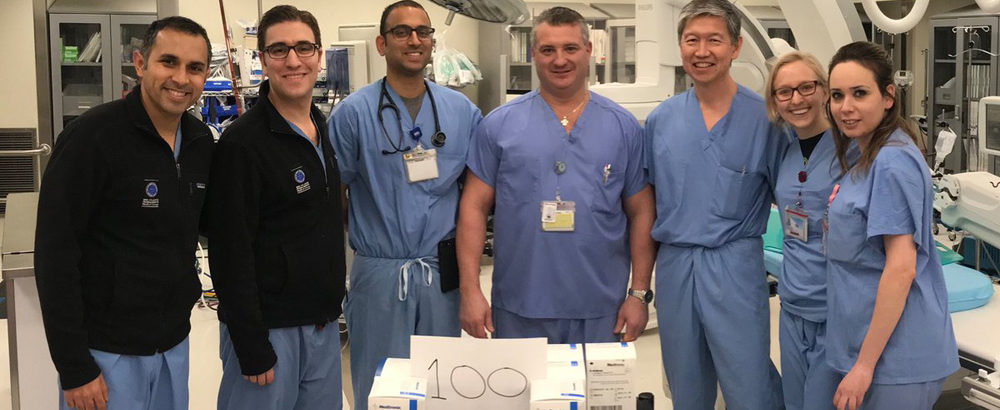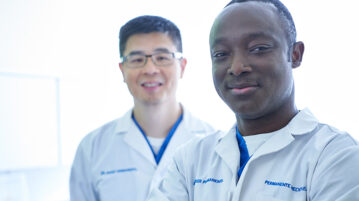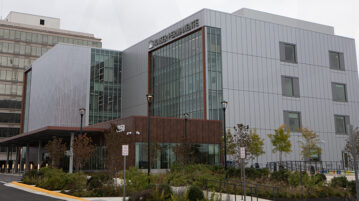The structural heart team at Tysons Corner Medical Center marked a milestone on Jan. 22, 2018, by performing its 100th interventional cardiology Transcatheter Aortic Valve Replacement (TAVR) procedure.
“It was a proud moment for us. But we decided that we were going to celebrate a month later with cake and champagne,” says Ameya Kulkarni, MD, who works with fellow cardiologists Benjamin Galper, MD, and John Golden, MD.
When Dr. Kulkarni and Dr. Golden introduced their TAVR program to MAPMG and to the region in 2016, they wanted to serve patients considered too sick or high-risk for surgical aortic valve replacement. A TAVR procedure uses X-ray cameras to deliver the valve through an artery in the leg.
Efficiency in scheduling was also key to their innovative program. “The fastest TAVR programs in the country can take about two to three weeks, from evaluation to procedure,” Dr. Kulkarni says. “We wanted to get all necessary tests done in one business day. Once you know you have a medical problem, you feel like you have a ticking time bomb. It’s our core ethos to solve it as quickly as possible.”
There are nine to 11 tests required in advance of TAVR, some of which can only be done at a hospital. At MAPMG, patients have their CT scan and a few other non-invasive tests in the morning at the Kaiser Permanente Tysons Corner Medical Center, then go in the afternoon to Virginia Hospital Center for their cardiac catheterization and consultation with cardiac surgery. One day of testing means minimal movement for elderly patients while respecting the needs and time of patients and caregivers. The TAVR office team coordinates the tests on a Thursday, with the procedure typically scheduled for the following Tuesday.
“Our one-day evaluation process is an excellent example of successful regionalization of care and is unprecedented, allowing us to offer incredibly rapid and efficient care for some of the sickest MAPMG patients from throughout the region,” says Dr. Galper, director of MAPMG’s Structural Heart Disease Program.
Traditionally, most TAVR patients spend four to six days in the hospital after the procedure. In 2017, the MAPMG TAVR team instituted a fast-track protocol for MAPMG patients to go directly to a step-down bed. “They are ambulating on their own by the night of their TAVR and are discharged to home within one to two days,” Dr. Galper explains. Sedation, not general anesthesia, helps with faster recovery. “Our length of stay and costs are lower, but our outcomes are comparable with the busiest TAVR programs in the country,” he notes.
The 16-person team of surgeons, anesthesiologists, nurses, cath lab technicians, and office staff never loses sight of the mission. “Aortic stenosis is a progressive disease that leads to shortness of breath with exertion, chest pain, and even passing out. Eventually it will be fatal, with 50 percent of patients dying within two years of developing symptoms,” Dr. Galper says. A successful TAVR procedure can help avert that fate. “It is a special feeling to know that through their TAVR, not only have we improved our patients’ quality of life, but we have saved them from certain death from heart failure.”
A proud Dr. Kulkarni concurs: “Our team took the program to a place beyond my imagination. It’s a well-oiled machine, one of the prides of Kaiser Permanente MAPMG.”
The innovative program is inspiring patients, too. A 74-year-old patient’s severe aortic stenosis was affecting even the simplest tasks, Dr. Galper recalls. “He was so short of breath that he could not even walk the 30 feet to his mailbox without stopping three times. On the day after his TAVR, I saw the patient, and he said, ‘Doc, let me show you something.’”
The patient proceeded to jump out of his hospital bed and run down the hall faster than either Dr. Galper or the nurse could run.
This time, they were delighted to be the ones out of breath.




